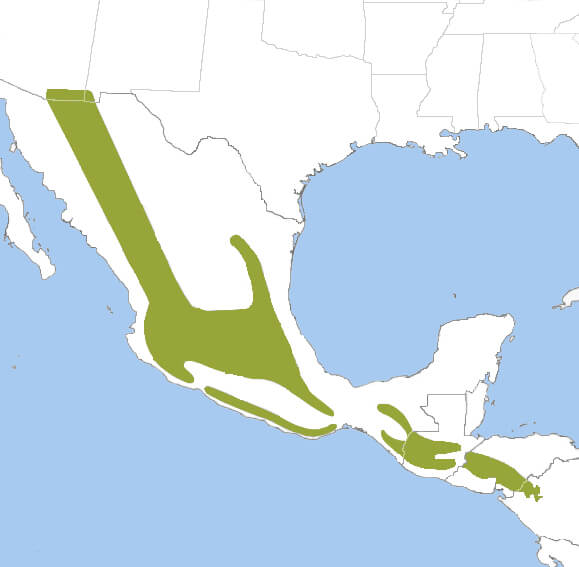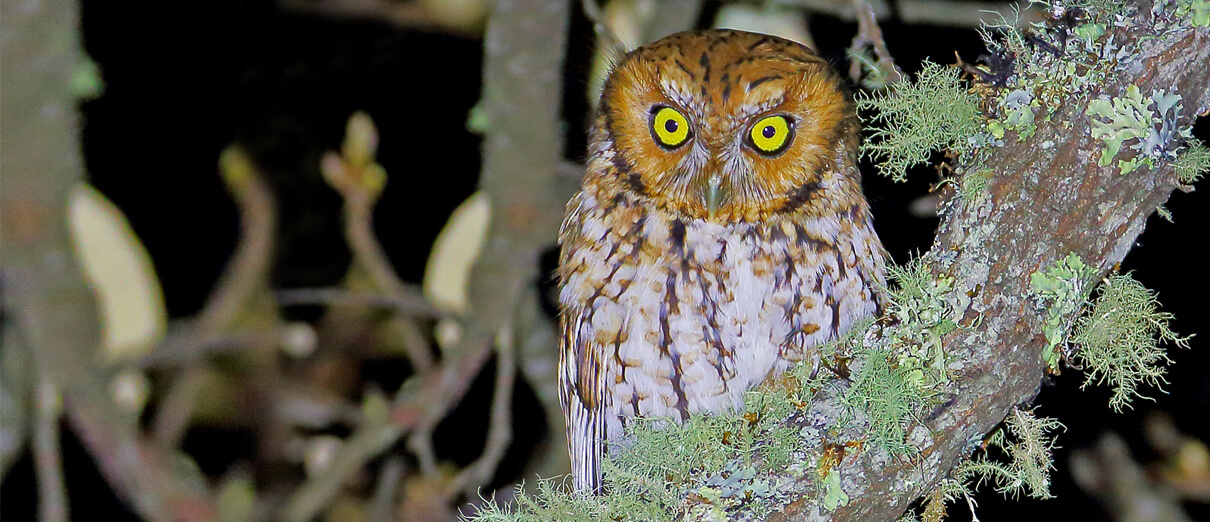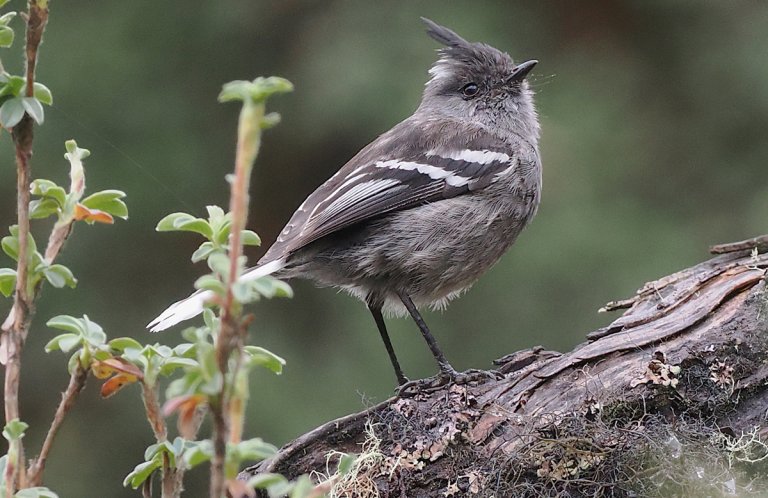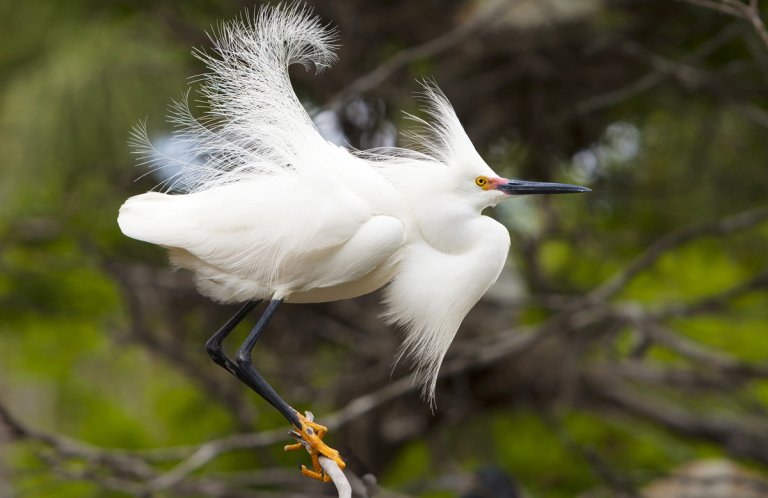
Whiskered Screech-Owl range map by Cornell Lab of Ornithology
A well-camouflaged little raptor, the Whiskered Screech-Owl's U.S. population even managed to hide from scientists until almost the dawn of the 20th century. It's easy to see why it took a while: Although a bit smaller and with slightly more heavily scalloped underparts, the Whiskered Screech-Owl very closely resembles the two other U.S. screech-owls, the Western and the Eastern. Once documented, the bird currently known as the Whiskered Screech-Owl was initially called the Arizona Whiskered Owl and Spotted Screech-Owl.
In the U.S., the Whiskered Screech-Owl only occurs in the “Sky Islands,” mountains rising from the desert in southeastern Arizona and an adjacent dollop of southwestern New Mexico, but the species' range extends far southward, through the mountains of Mexico and into Central America as far as Nicaragua. Aptly named, this bird does have longer, thicker facial plumes than its cousins, but these are usually only seen with the bird “in hand,” or in close-up, zoomed-in photos.
The Whiskered Screech-Owl often lives at higher elevations than its look-alike neighbor the Western, but the two species do occur in some of the same places. In such situations, the best way for birders to parse out the two species is by listening to them because, usually, they are easily separated by sounds they make.
Screeching Out
In the southwestern mountains where both Whiskered and Western Screech-Owls live, two words – “steady” and “bouncing” – guide birders to safe screech-owl identifications. After night falls, the Whiskered's fast but even series of “ho” calls contrasts that of the Western, which has a song of accelerating notes often compared to the sound of a bouncing rubber ball. (Hear the songs below.)
Mottled with gray, black, and white, a roosting Whiskered Screech-Owl blends well with tree bark and sun-dappled tree foliage. Its piercing yellow eyes have a somewhat orangey tint. And, typical of screech-owls, it has small “ear” tufts. A rufous color morph occurs in the southern part of the species' range.
Hoots in the “Hills”
Within the Whiskered Screech-Owl's small U.S. range, it frequents oak and pine-oak woods and adjacent sycamores. Pine-oak woodlands also host this bird in mountains running south through Mexico to northwestern Nicaragua, although the rufous form has been found in cloud forest. Within these montane habitats, the Whiskered Screech-Owl is nonmigratory. In the Southwest and northern Mexico, though, it may at times move to lower elevations in winter.
The Whiskered's typical song lasts a few seconds and consists of a rapid series of five to eight soft hoots: ho-ho-ho-ho-ho-ho-ho. The female's song is somewhat higher-pitched than the male's. Another song has notes of varied lengths that remind some of the sound of Morse code being relayed.
Listen here to compare songs of the Western Screech-Owl and the featured Whiskered Screech-Owl:
(Audio: Peter Boesman, XC227071. Accessible at www.xeno-canto.org/227071. Andrew Spencer, XC17925. Accessible at www.xeno-canto.org/17925.)
Busy Night Shift
Invertebrates beware! After dark, the Whiskered Screech-Owl leaves the shelter of roost and nest sites, aiming to grab moths, beetles (including large June beetles), katydids, crickets, grasshoppers, caterpillars, spiders, and even centipedes and scorpions.
From time to time, this opportunistic hunter also catches bats and small rodents, shrews, smaller birds, lizards, and small snakes. To nab prey in the air, the owl often hunts from strategic perches, flapping silently after flying insects, or dropping to the ground to pounce on prey. Also, it sometimes flies through the foliage, seeking opportune meals as it passes limbs and leaves. In wooded areas with houses and streets, the Whiskered Screech-Owl may be seen hunting flying insects drawn to lights shining at night.

Whiskered Screech-Owl, rufous morph. Photo by Greg Homel, Natural Elements Productions.
This little owl also can become prey to predators sharing its habitat. These likely include the Cooper's Hawk and “Mexican” Spotted Owl. Although sheltered in tree cavities, eggs and nestlings fall prey to arboreal predators including snakes and the Northern Raccoon, Ringtail, and White-nosed Coati.
Nesting Neighbors
Whiskered Screech-Owl pairs stay together through the breeding season. Males defend their territories with frequent hooting sessions and by sometimes attacking trespassing males of their species. This owl nests both in naturally occurring cavities and, less frequently, in abandoned woodpecker holes, usually between ten and 30 feet up. Within a territory, a male often defends more than one cavity. In cavities where these owls don't nest, they may roost or store food.
Although aggressive toward members of their own species, Whiskered Screech-Owl pairs have been documented nesting alongside Elegant Trogons, Acorn Woodpeckers, and Flammulated Owls in the same trees.
Other wildlife may even coexist with these owls inside their nest cavities. Blind snakes are sometimes prey, but if they escape and occupy the nest, they feed on insects that might compete with nestlings for food. In addition, the tree ants that sometimes occupy the screech-owls' cavities may attack intruders but leave the owls unmolested.
The female Whiskered Screech-Owl lays between two and four white eggs, incubating them for three to four weeks. The male does not incubate, but brings the female food at the nest site. Nestlings fledge about 50 days after hatching.
Watch Carefully
Although not considered globally threatened, the Whiskered Screech-Owl is thought to be declining in North America and was included on the 2016 State of North America's Birds' Watch List. Contributing to this species' decline is habitat loss and also habitat degradation, through clearing of nesting and roosting trees. In developed areas within this owl's habitat, collisions with cars can pose a threat.
The species remains fairly common in many areas. In its small U.S. range, the Whiskered Screech-Owl is a frequent target of birders. Peak visitation at top southeastern Arizona birding sites in spring may impact nesting success, when dozens of birders appear night-after-night at nest sites, particularly if extensive playback recordings and strong spotlights are used.
ABC's BirdScapes approach guides conservation and restoration of key habitats, including oak and pine-oak habitats used by the Whiskered Screech-Owl, Flammulated Owl, Mexican Jay, Painted Redstart, Acorn Woodpecker, and many other species.
Donate to support ABC's conservation mission!



















































